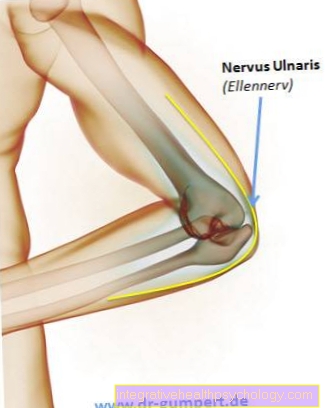Swelling on the side of the neck
Definition - What is a Lateral Neck Swelling?
A swelling on the side of the neck usually refers to a more or less pronounced bump located on the neck.
Various structures run along the side of the neck: for example, there are the vessels that supply the head with blood and transport it away again. Muscle strands also pull along the side of the neck. There are many lymph nodes on these muscle strands, which can also be involved in swelling.
A swelling on the side of the neck can basically originate from deep structures as well as superficially from the skin, for example.

Causes of the swelling on the side of the neck
-
Swelling of the lymph nodes (possible on one and both sides)
-
Inflammation
-
Inflammation of the salivary glands
-
Tonsillitis
-
Superficial inflammation on or directly below the skin (e.g. abscess)
-
Mastoiditis (inflammation of the mastoid)
-
-
Neck cyst, throat fistula
-
New tissue formation
-
Lipoma
-
tumor
-
Lymph node swelling in the neck
There are many lymph channels on the side of the neck, which are equipped with a corresponding number of filter stations, the lymph nodes. The lymph nodes are mainly in front of and behind the superficial Sternocleidomastoid muscle (big turner). Therefore, swelling often forms there when there is swelling of the lymph nodes.
The swelling is often a sign of systemic infection in the body. The lymph nodes play an important role in our immune system and are therefore particularly challenged during infections, which is why they swell in infectious diseases. However, the lymph nodes can also swell in malignant diseases such as tumors or HIV. Often only a few lymph nodes are affected, which swell particularly prominently.
Read more on the topic: Lymph node swelling in the neck - how dangerous is it?
Abscess on the neck
An abscess is a collection of pus that is usually located below the skin. Classically, an inflammatory stimulus leads to the formation of many inflammatory cells. With these cells, the body tries to fight the inflammation. If this does not succeed completely, a collection of pus develops, which forms a small cavity in the tissue. This cavity filled with pus is called an abscess.
Such an abscess can arise from superficial inflammation of the skin on the side of the neck and from there penetrate deeper into the tissue. The other way round, inflammation, which originates in deeper tissue layers, is also possible. In these cases, the swelling only becomes apparent when the abscess has already become somewhat larger.
Read more on the topic: Abscess treatment or home remedies for an abscess
Cervical cyst
A cyst classically describes a fluid-filled space, which is characterized by a tissue capsule. The exact cause of the cervical cyst has not yet been finally clarified, but it is suspected that an anomaly in the embryonic development promotes the formation of the cervical cyst.
If the neck cyst is on the side, it is called a lateral neck cyst, which causes swelling on the side of the neck. However, there are also median cervical cysts. The cause of the lateral cervical cyst cannot be treated.
A puncture of the cyst with a fine needle is usually done for diagnostic purposes, as this allows the fluid to be analyzed. However, it is usually not suitable for therapeutic purposes, since the cyst fills itself again even after the fluid it contains has been withdrawn.
Throat fistula
The neck fistula represents the next stage of the neck cyst. Here, too, the exact reason for the formation is not known. However, the fistula usually arises from the fact that the previously closed neck cyst forms a connection to another fluid-filled space or cavity. The fistula typically describes the connection between these two spaces. A fistula can appear as an internal fistula (connection to an internal organ, for example) or as an external fistula (opening to the skin).
Mastoiditis
The mastoid is a bony mastoid process of the temporal bone and lies slightly behind and below the ear. Mastoiditis is the inflammation of this part of the bone. Typically, mastoiditis develops as a result of a poorly healing otitis media.
There is a swelling on the side of the neck, a little behind the ear. Ear pain and hearing impairment can also occur. With severe mastoiditis, there is no local inflammatory reaction, and the body can also react with a fever.
Dangerous complications of mastoiditis occur when the inflammatory response works its way through the thin bone into the brain. This leads to inflammation of the meninges (meningitis) and can have serious consequences.
Read more on the topic:
- Swelling Behind the Ear - What Are the Causes?
- Therapy of mastoiditis
Salivary gland inflammation
Salivary glands are glands that belong to the digestive tract. They contain various enzymes that help digest food. Most salivary glands are located right at the beginning of the digestive tract and have their ducts in the mouth.
A salivary gland lies just below the tongue (sublingual), one is on the lower jaw (submandibular) and one is in front of the ear (Glandula parotis).
The lower jaw and parotid glands in particular can cause swelling on the side of the neck if they are infected. Such an inflammation typically arises from a blockage of the ducts, often with salivary stones, more rarely with tumors.
Read more on the topic:
- Inflammation of the salivary glands
- Home remedies for salivary stones
- This is how you can effectively remove salivary stones
Lipoma
A lipoma is a benign new formation of fatty tissue. This can basically occur anywhere on the body and does not initially cause any symptoms. From a certain size, however, a swelling is noticeable in the affected area. If such a lipoma is on the side of the neck, there is a one-sided swelling on the neck.
The lipoma does not need to be treated at first because it is benign. However, due to its size, it can quickly become a problem especially on the neck. The swelling can press on the important blood vessels in the neck, causing complications. Surgical removal of the lipoma is therefore usually indicated because of the expected complications or for aesthetic reasons.
Read more on the topic:
- Treatment of a lipoma
- Operation of a lipoma
Purulent tonsillitis
In the case of purulent tonsillitis, the tonsils are usually inflamed due to a bacterial infection in the throat. This inflammation is accompanied by severe swelling and reddening of the tonsils.
Typically, swallowing is particularly painful in tonsillitis. If the swelling is particularly pronounced due to the inflammation, the swelling can also be visible from the outside. In this case, there will be swelling on both sides of the neck. This swelling is usually also tender on pressure.
Read more on the topic: Home remedies for swallowing difficulties
Diagnosis of swelling on the side of the neck
Diagnosing side neck swelling consists of several steps. Since the causes of such a swelling are particularly diverse, the anamnesis is a particularly important step in the diagnosis. The doctor asks the person concerned specific questions to find out the cause of the swelling.
Depending on which cause the doctor then suspects, various diagnostic steps are initiated. The first thing that usually follows is the physical examination, during which the swelling is felt. Imaging can then take place, for example by means of ultrasound.
Other accompanying symptoms of swelling on the side of the neck
The most typical accompanying symptom of the neck swelling is pain. The swelling itself is assessed based on its size and consistency (firm, soft, movable, etc.). Depending on the clinical picture, other symptoms occur.
For example, tonsillitis can cause discomfort in the throat, especially when swallowing and speaking. If an abscess forms, there is usually also swelling and reddening of the affected area. If there is an infectious disease, fever, fatigue, headache and body aches can also occur.
Read more on the topic:
- Causes of difficulty swallowing
- Almond abscess
Pain in the swelling on the side of the neck
Pain is one of the main indicators of what is causing the side neck swelling. Painful swellings usually indicate an acute process such as inflammation.
If the swelling occurs without pain, a more prolonged process is suspected.
If there is pain in connection with the swelling, one suspects swelling of the lymph nodes, tonsillitis or salivary gland inflammation. An abscess is also noticeable as a painful swelling.
Painless swellings, on the other hand, can be caused by cysts or a lipoma, for example.
Treatment of swelling on the side of the neck
Therapy for swelling on the side of the neck depends primarily on the cause. Inflammation of any kind is mostly treated symptomatically. This includes drug therapy with painkillers, and cooling the neck region can provide relief. A purely symptomatic treatment of the symptoms is often sufficient. The swelling and accompanying symptoms usually go away within a few days.
More detailed therapy is necessary if the symptoms are not expected to subside quickly. If there is bacterial inflammation, antibiotics can be used to treat it.
In the case of non-inflammatory diseases, surgical treatment of the cause of the swelling may be necessary. For example, neck cysts and fistulas are usually removed surgically because there is a fear of an infection of the structures. Lipomas of a certain size are also operated on.
Read more on the topic: A Sore Throat - How To Get Rid Of It Quickly!
Duration and prognosis of side neck swelling
The duration of the symptoms depends on the cause of the swelling. Inflammatory processes usually disappear after a few days to two weeks, provided they do not establish themselves as an abscess.
Cysts, fistulas, lipomas, etc. are chronic processes that can last longer.
Most causes of swelling on the side of the neck can be remedied well with drug or surgical therapy. If there is a malignant cause of the swelling, the disease lasts significantly longer, and the prognosis varies greatly depending on the type of disease.
Disease progression of swelling on the side of the neck
Just like the therapy and prognosis of the swelling on the side of the neck, the course of the disease is also largely dependent on the cause. Basically, acute processes become noticeable within a few days and initially worsen, after a few days the symptoms get better and the symptoms usually subside completely after a few weeks.
Chronic processes develop over months to years and only become symptomatic at a late stage.

















.jpg)











